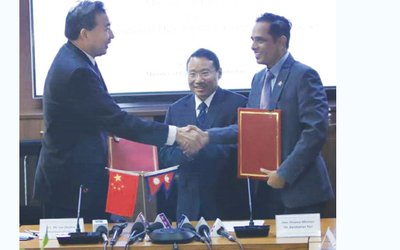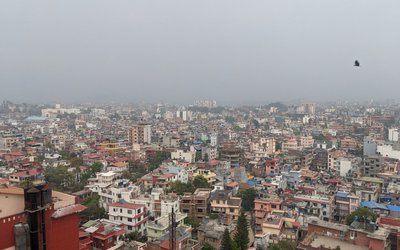Dr. Maria Elena G. Filio-Borromeo, shortly called “Marlyn” has been working as the UNAIDS Country Coordinator for Nepal and Bhutan since late 2007. She spoke to New Spotlight on various issues. Excerpts:
As the world is celebrating International Women’s Day, how do you see the state of women particularly in Nepal in terms of HIV/AIDS prevalence?
Let me first greet all our readers a Happy Women’s Day not only onoon on March 8, but in the next days ahead. We should make every day, a Women’s Day! 2012 actually marks the 101st Anniversary of the International Women’s Day and it’s great that Nepal is joining the world in celebrating this very important event.
On the state of Nepali women, using the HIV/AIDS lens, I wanted to bring forth the reports from the National Center on AIDS and STD Control (NCASC) of the Ministry of Health and Population (MOHP). As of Aug 2011, a cumulative total of 18,535 HIV infections have been reported to
NCASC, and almost 36% are women. Among these women, 75% are housewives. If you look at the 2010 Estimated HIV infections by risk groups in 2010 released also by NCASC, you will also deduced that 27% are among women: 1% among female sex workers and 26% among remaining low risk women.
Clearly, the trend of HIV infection in Nepal is dramatically changing from “most-at-risk” women to “low-risk” women. In the context of HIV epidemiology housewives are classified as “low risk” Population since in general they only have 1 sexual partner. Their level of risk to HIV exposure Therefore is very much defined by the sexual (and injecting drug) practices of their husband. This Situation is alarming since the likelihood of transmitting HIV to unborn children will be high.
As there grows the mobility of Nepal’s men, how safe Nepalese women are?
Following up on my response on your first question, most of those reported as “housewives” are apparently housewives of migrant workers. So this needs to be carefully studied and adequately addressed. Mobility, whether by men or women, is a vulnerability factor to HIV infection. While families and the country’s economy as a whole enjoy the benefits of dollar remittances from migrant workers, the social cost could be high at times.
As Nepal has reportedly made a big progress in stabilizing HIV/AIDS, how friendly is Nepal’s HIV policy towards women?
Nepal has good policies in place- including having women-friendly policy and even third gender-friendly policy. The challenge as in other countries is the implementation of these policies so that the spirit and intent of these policies will be achieved. If you look at the 2011 July report of NCASC on antiretroviral therapy (ART) coverage, 43.1% are females, 56.5% are male and 0.3% is third gender. So women are reaching these life-saving medications.
During my first year in Nepal, the government had introduced the Free Universal Health Care policy with the aim or reaching “very poor”, “destitute”, “senior citizens”, supported by “women community health volunteers”. I recall reading a study a couple of years after, which found out that the increase in utilization of health care services within government-run facilities by women and girls is apparently evident because of this pro-poor health care policy. So this is a big progress in Nepal’s policy implementation where concrete results are seen in the lives of women and girls.
How do you see the gender scenario in terms of HIV/AIDS?
Last year, UNAIDS Nepal supported a “Gender Audit of the HIV response in Nepal”. This is in line with our “Agenda for Accelerated Country Action for Women, Girls, Gender Equality and HIV” developed to address the persistent gender inequalities and human rights violations that put women and girls at greater risk of, and more vulnerable to, HIV and that threatens the gains that have been made in preventing HIV transmission and in increasing access to ART. I can share with you the full report, but it noted that the country’s response to HIV since it was first reported in 1988 had evolved. From a mainly health-focused response, a developmental, rights-based approach has been adopted through the years. However, it also noted that the response to HIV and AIDS to date has not been bereft of gender perspective altogether and much has yet to be done, to ensure that policies and programs on HIV and AIDS indeed facilitate gender equality.
How do you see the resources available in Nepal for HIV/AIDS?
Resources for HIV/AIDS in Nepal and in other countries would never be enough, I think. There is always a clamor for more, more, and more. With the current global economic downturn, the smart and better way to go is to make more effective and efficient use of resources that are already available in the country.
According to the study on the “Resource Inflow for the HIV/AIDS Program in Nepal 2010” carried out by the HIV/AIDS and STD Control Board (HSCB) with technical support from UNAIDS and World Bank, Nepal had spent $ 20.5 Million in 2009; and in 2010 about $19.1 Million had been obligated, for HIV/AIDS response. The same study deduced that the HIV/AIDS response in Nepal is almost totally dependent on external support (more than 98% of funds come from external sources), but the trend is now on its downward direction. Hence, to preserve and sustain the gains on HIV/AIDS, it is absolutely necessary that domestic resources, both from the government and private sector, be mobilized. The county will now be developing a costed National Action Plan on HIV/AIDS and it will tell us how much resources/investment is needed to address the epidemic effectively and achieve down the road, the targets set in the National Strategy on HIV/AIDS 2011-2016, and midway the MDG 6 target 7 by 2015.
What is the total budget and what is the contribution of international community?
I refer you back to the study I mentioned earlier, the “Resource Inflow for the HIV/AIDS Program in Nepal 2010”. According to this study, the contribution from external sources during the fiscal year 2009/2010 is a little over $20 million.
Existing data has shown that HIV is gradually infecting housewife, what Nepal needs to do?
Nepal has vast experiences in reducing HIV infections among its population, so I don’t think I need to mention what needs to be done. But on the issue of reducing, if not eliminating, HIV infection among housewives, a comprehensive, continuum of HIV prevention program has to be in place at all levels and specially for housewives, at the community, family and individual levels. Multiple approaches at various entry points, is needed. If the profile of the housewives is that of the wives of migrant workers, which in Nepal is likely to be, then prevention program for migrant workers has to be in place in the whole migration process, which includes during pre-departure, while in host countries, and upon return or reintegration in their community.
Let me mention, as we are on this topic, that the UN Theme Group on AIDS in Nepal is seriously concerned about this emerging issue and had developed a joint UN initiative on “Reducing Migration related vulnerabilities and risk of HIV transmission among Nepali men and women”. This is a 3-year initiative and one of its objectives is to strengthen cross border initiative between Nepal and India to enable the continuum of services such as sexual and reproductive health, HIV testing and counseling, prevention of mother to child transmission and ARV for migrants and their spouses. It is envisaged that this initiative will contribute to the national response with a focus on reducing HIV/STI/TB transmission among Nepali migrant populations in intervention districts.
How do you see the role of International agencies and local civil society organizations?
Everyone has a role in addressing HIV and AIDS. Certainly, the Government is on the driving seat- setting the strategic direction of the response, based on what the epidemic is telling us and in the country’s long-term development vision.
Civil society organization (CSOs) especially people living with HIV plays multiple roles in HIV and AIDS response. This had been seen in all countries around the world, including Nepal. Their engagement in accessing and/or providing prevention, treatment, care and support services is essential. They could also provide a forum to discuss controversial issues that help promote deeper understanding about HIV and related issues among decision makers and political leaders. In some countries, CSO pilots community-based intervention and once successful, the Government scales it up, to national level. CSOs could also play a vital role in advocacy particularly in helping address stigma and discrimination and in drafting national legislations that addresses these issues.
International agencies bring in and share good practices that have proven to work effectively in other countries or in other similar settings. They contribute by providing normative guidance, technical assistance, resource mobilization, capacity development and in some instances, funding support.
- TANAHU HYDROPOWER PROEJCT: A Significant Achievement
- Apr 15, 2024
- AMBASSADOR HANAN GODAR: Sharing Pain With A Nepali Family
- Mar 30, 2024
- VISIT OF KfW AND EIB TO NEPAL : Mission Matters
- Mar 25, 2024
- NEPAL BRITAIN SOCIETY: Pratima Pande's Leadership
- Mar 24, 2024
- NEPAL ARMY DAY: Time To Recall Glory
- Mar 15, 2024
















